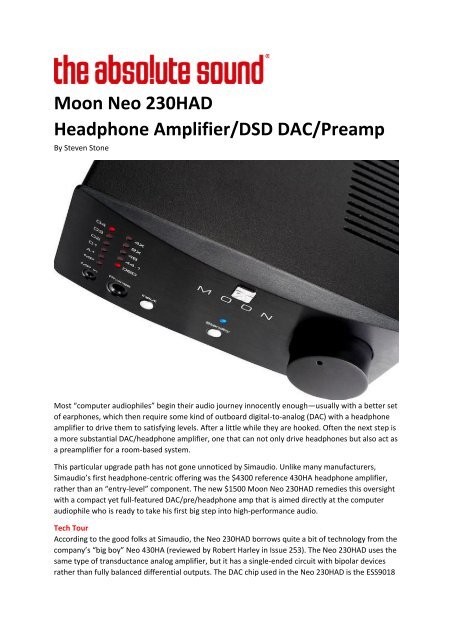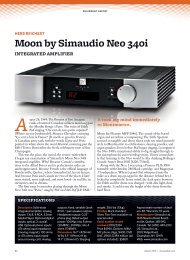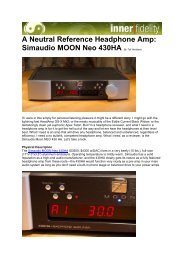Moon Neo 230HAD Headphone Amplifier/DSD DAC/Preamp
MOON_Neo_230HAD_absolutesound
MOON_Neo_230HAD_absolutesound
Create successful ePaper yourself
Turn your PDF publications into a flip-book with our unique Google optimized e-Paper software.
<strong>Moon</strong> <strong>Neo</strong> <strong>230HAD</strong><br />
<strong>Headphone</strong> <strong>Amplifier</strong>/<strong>DSD</strong> <strong>DAC</strong>/<strong>Preamp</strong><br />
By Steven Stone<br />
Most “computer audiophiles” begin their audio journey innocently enough—usually with a better set<br />
of earphones, which then require some kind of outboard digital-to-analog (<strong>DAC</strong>) with a headphone<br />
amplifier to drive them to satisfying levels. After a little while they are hooked. Often the next step is<br />
a more substantial <strong>DAC</strong>/headphone amplifier, one that can not only drive headphones but also act as<br />
a preamplifier for a room-based system.<br />
This particular upgrade path has not gone unnoticed by Simaudio. Unlike many manufacturers,<br />
Simaudio’s first headphone-centric offering was the $4300 reference 430HA headphone amplifier,<br />
rather than an “entry-level” component. The new $1500 <strong>Moon</strong> <strong>Neo</strong> <strong>230HAD</strong> remedies this oversight<br />
with a compact yet full-featured <strong>DAC</strong>/pre/headphone amp that is aimed directly at the computer<br />
audiophile who is ready to take his first big step into high-performance audio.<br />
Tech Tour<br />
According to the good folks at Simaudio, the <strong>Neo</strong> <strong>230HAD</strong> borrows quite a bit of technology from the<br />
company’s “big boy” <strong>Neo</strong> 430HA (reviewed by Robert Harley in Issue 253). The <strong>Neo</strong> <strong>230HAD</strong> uses the<br />
same type of transductance analog amplifier, but it has a single-ended circuit with bipolar devices<br />
rather than fully balanced differential outputs. The <strong>DAC</strong> chip used in the <strong>Neo</strong> <strong>230HAD</strong> is the ESS9018
K2M, but a <strong>DAC</strong> is far more than the chip used. The <strong>Neo</strong> <strong>230HAD</strong> employs one large 10VA toroidal<br />
transformer in its power supply along with eight DC voltage stages—four for each channel to ensure<br />
proper regulation.<br />
The <strong>Neo</strong>230 HAD has two pairs of single-ended RCA outputs. One pair is fixed-level while the other is<br />
variable, controlled by the front panel volume knob. The front panel has one ¼" stereo headphone<br />
output that can generate 200mW into a 300-ohm load and 1W into a 50-ohm load. Accepted formats<br />
and bit rates include PCM up to 384/32 and <strong>DSD</strong> up to <strong>DSD</strong>256 via the USB inputs. SPDIF accepts up<br />
to 192/24 PCM, but not <strong>DSD</strong>, while the TosLink can handle up to 192/24 PCM.<br />
Ergonomics and Setup<br />
The <strong>Neo</strong> <strong>230HAD</strong>’s chassis is 7 inches wide by 3 inches high by 11 inches deep, which is what used to<br />
be referred to as a “half-size” width when rack-mount-sized components ruled the earth. The front<br />
panel is curved, which gives the <strong>Neo</strong> <strong>230HAD</strong> less of a boxy look. It is populated by a large volume<br />
knob on the right side, a small blue LED above the on/off button in the center, and an input button,<br />
two rows of blue LEDs, a ¼" headphone output, and a 3.5mm stereo input on the left side. These<br />
rows of LEDs designate the source input as well as the bit-rate of the current program material.<br />
The back panel of the <strong>Neo</strong> <strong>230HAD</strong> has one TosLink, one USB, and two SPDIF inputs, as well as one<br />
pair of RCA analog inputs. The rear panel also has two pairs of RCA single-ended analog outputs—one<br />
fixed and one variable—and a standard IEC AC connection.<br />
Setup was simple and straightforward. I attached a USB input from my 2015 MacPro desktop and for<br />
the initial installation I ran the fixed-level outputs into the input of the Tortuga Audio LDRV3.V2<br />
passive preamplifier. I also used the <strong>Neo</strong> <strong>230HAD</strong> connected directly to a power amplifier via its<br />
variable outputs.<br />
Unlike some <strong>DAC</strong>s which offer you several different digital filter options, usually fast, slow, and<br />
minimum phase, the <strong>Neo</strong> <strong>230HAD</strong> has no filter adjustments. Its controls are minimalist to the point
that instead of giving users the option of having either fixed or variable output on both single-ended<br />
outputs, Simaudio chooses to permanently designate one fixed and one variable. Thus, no switch is<br />
needed. While I would prefer to see the option of fixed or variable, this solution certainly works. But<br />
if you require two variable (one for your power amplifier and one for your subwoofer) or two fixed<br />
outputs (one for your preamp and one for your Stax or balanced headphone amplifier), you will need<br />
to use signal splitters for those connections.<br />
The <strong>Neo</strong> <strong>230HAD</strong> comes with the <strong>Moon</strong> CRM-2 full-function remote control, which also works with<br />
several other <strong>Moon</strong> components. The functions that work include input selection, volume control,<br />
and power on/off. As for the rest, such as balance and mute, don’t hold your breath waiting for<br />
something to happen after you press the remote’s buttons.<br />
Very occasionally, when going from PCM material to <strong>DSD</strong> files, there would be a very short period of<br />
noise before the <strong>Neo</strong> <strong>230HAD</strong> locked on the <strong>DSD</strong> signal. This only occurred for me while using<br />
Audirvana+, but I would recommend the “best practices” of not leaving your volume control up when<br />
switching between PCM to <strong>DSD</strong> files.<br />
Performance<br />
Although the <strong>Neo</strong> <strong>230HAD</strong> includes several different devices whose functions are relatively<br />
independent—<strong>DAC</strong>, preamp, and headphone amplifier—most of the time they will be used together,<br />
such as when you listen through headphones. And while it’s possible to bypass the volume control by<br />
using the <strong>Neo</strong> <strong>230HAD</strong>’s fixed-level outputs and routing them to a preamplifier or external<br />
headphone amplifier (which I did during the review), the whole point of the <strong>Neo</strong> <strong>230HAD</strong> is that it<br />
can be used as a one-box component that simultaneously serves as a digital hub, preamplifier, and<br />
headphone amplifier for all but the most complex multi-input systems.<br />
When used as a preamplifier the <strong>Neo</strong> <strong>230HAD</strong> was dead silent. The <strong>Neo</strong> <strong>230HAD</strong> also had oodles of<br />
gain—at normal, moderately loud listening levels I barely got up to 9 o’clock on a rotary dial that<br />
starts at 7 o’clock! Splitting the unbalanced signal into two unbalanced signals so I could run both my<br />
main amplifier and subwoofer did not seem to reduce the signal levels one iota.<br />
Through a system that is so transparent that I could clearly hear the NuPrime ST10 power amplifier<br />
warm up after being turned off for a day, the soundstage started flat with almost no depth, and<br />
gradually, over the next 30 minutes, deepened and expanded to its normal dimensions. I could also<br />
hear how little the <strong>Neo</strong> <strong>230HAD</strong> altered the sound, especially on material I was familiar with. A<br />
recent guilty pleasure, the cut via Tidal “Dracula” from Bea Miller’s Not an Apology, has some very<br />
deep bass pulses combined with some very rude percussion crashes that can sound either very cool<br />
or sorta cruddy depending on your system’s high-level dynamic resolution and low bass capabilities.<br />
On my nearfield system it can rock, and with the <strong>Neo</strong> <strong>230HAD</strong> in the signal chain, it did.<br />
I connected a wide variety of earphones to the <strong>Neo</strong> <strong>230HAD</strong>’s headphone output and I was<br />
impressed by how many the <strong>Neo</strong> <strong>230HAD</strong> drove well. With hypersensitive low-impedance in-ears<br />
such as the Westone ES5, I could hear a very slight amount of white-noise hiss even when the<br />
volume control was turned all the way down, but at normal listening levels this hiss level remained<br />
low. With any “regular-sensitivity earphone (between 85 and 95dB)” the <strong>Neo</strong> <strong>230HAD</strong> generated a<br />
silent background.<br />
With my most difficult-to-drive headphones, which are currently the Beyerdynamic DT-990, 600-ohm<br />
version, the <strong>Neo</strong> <strong>230HAD</strong> had lots of gain left in reserve. The volume control barely cracked 10<br />
o’clock. The <strong>Neo</strong> <strong>230HAD</strong> also proved to be a good pairing with difficult-to-match headphones such<br />
as my newly acquired Sennheiser HD 700.
Summary<br />
A scant few years ago you would have been hard-pressed to find a high-performance entry-level<br />
<strong>DAC</strong>/pre/headphone amplifier from an industry-leading audio manufacturer for around $1500.<br />
Nowadays, audiophiles have a lot of options, including three that I have had extensive experience<br />
with—the NuPrime <strong>DAC</strong>-10H ($1795), the Oppo HA-1 ($1199), and the <strong>Moon</strong> <strong>Neo</strong> <strong>230HAD</strong> ($1500).<br />
Although the <strong>Moon</strong> <strong>Neo</strong> <strong>230HAD</strong> has fewer adjustments and lacks balanced headphone outputs, its<br />
sonics, especially when used as a preamplifier, placed it above the Oppo. The <strong>Neo</strong> <strong>230HAD</strong> was closer<br />
to the level of neutrality I’ve become accustomed to hearing from the Tortuga Audio LDRV3.V2<br />
passive preamplifier. (In comparison, the Oppo HA-1 was slightly warmer harmonics with a more<br />
pronounced midbass.) The <strong>Neo</strong> <strong>230HAD</strong> also has a slightly more coherent soundstage with easier to<br />
locate depth cues—there was better isolation around each instrument and each voice had less of<br />
what, for lack of a better term, I’ll call a “noise halo,” slightly blurring the edges of each instrument in<br />
a mix. The NuPrime <strong>DAC</strong>-10H offers quite a bit more flexibility (balanced headphone and analog<br />
outputs as well as different gain and filter settings), but sonically I found the <strong>Neo</strong> <strong>230HAD</strong> and <strong>DAC</strong>-<br />
10H to be a sonic dead heat, with both producing hard-to-fault sound. While I would rate the <strong>DAC</strong>-<br />
10H as a somewhat better value because of its features, for many nearfield and desktop systems that<br />
added flexibility may be overkill, at which point the <strong>Neo</strong> <strong>230HAD</strong> would be a more cost-effective<br />
choice. Usually at this point in a review of an “entry-level” component reviewers dredge up the<br />
phrase “gives you a taste of the high end.” The <strong>Moon</strong> by Simaudio <strong>Neo</strong> <strong>230HAD</strong> gives you far more<br />
than a taste—it will fatten you right up. If you don’t require a balanced headphone output, the <strong>Neo</strong><br />
<strong>230HAD</strong> may be all the <strong>DAC</strong>/preamp/headphone amplifier you ever need.<br />
Specifications<br />
<strong>Headphone</strong> impedance: 20–600 ohms<br />
Output power: 100mW into @ 600 ohms, 200mW into 300 ohms, 1W into 50 ohms: Inputs: One pair unbalanced on RCA jacks,<br />
one 1/8" mini-jack<br />
Input impedance: 22k ohms<br />
Single-ended headphone output: Stereo TRS<br />
Single-ended preamp outputs (RCA): Two pairs (fixed and variable)<br />
Frequency response: 20Hz–20kHz +/-0.1dB<br />
Output Impedance: 1.25 ohms<br />
Weight: 6.2 lbs.<br />
Dimensions: 7"x 3" x 11





